Microsoft Surface Pro 3 Review
by Anand Lal Shimpi on June 23, 2014 3:55 AM EST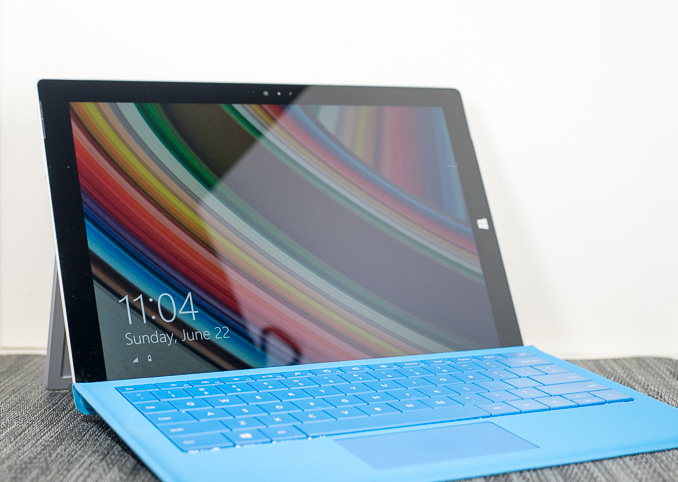
I can't believe it's only been sixteen months since I published our review of the original Microsoft Surface Pro. It feels like longer but that's likely because Surface RT made its sale debut a few months prior to that, and both devices were announced in the Summer of 2012. As far as an end user is concerned however, in February 2013 Microsoft released Surface Pro and proceeded to deliver two more iterations of the hardware in sixteen months. That's three Surface Pros in less than two years.
While the last two were largely similar, the third time is definitely more charming. Surface Pro 3 abandon's Microsoft's 10.6-inch 16:9 form factor in favor of 12-inch 3:2 design. The result is a far less cramped design, and one that does a better job of approximating a normal laptop. To offset the increase in surface area, Surface Pro 3 goes on a substantial diet and shrinks to only 9.1mm thick. Despite using the same SoC as Surface Pro 2, the 3rd generation device is substantially thinner.
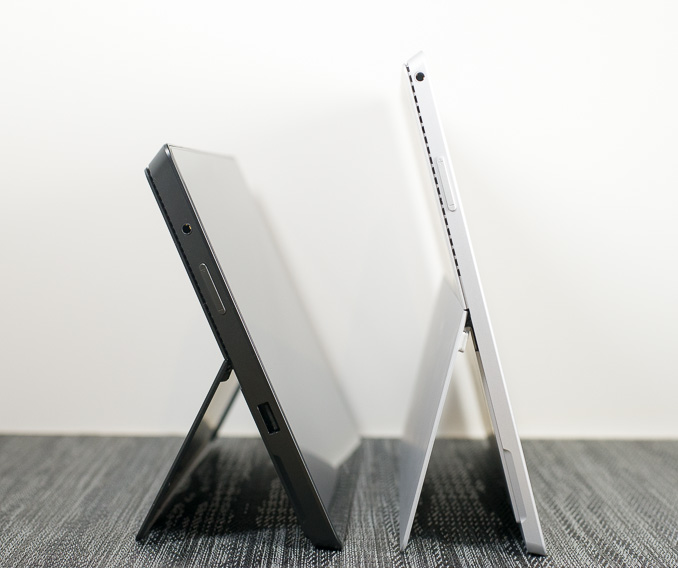
Surface Pro 2 (left) vs. Surface Pro 3 (right)
When Surface first launched, Microsoft set out to prove to the world that it too could build a thoughtfully designed, premium device. Much was said about Microsoft's custom injection moulded Magnesium process, VaporMg, and the extensive testing of the Surface kickstand and hinge. The latter was said to be able to last for over a million actuations.
Surface Pro 3 retains all of the build quality goodness that made the previous designs so unique in the Windows space. The chassis is still made out of Magnesium (although Microsoft curiously has dropped the term VaporMg), and now features the same lighter finish as Surface 2. The design is far more squared off than what we're used to seeing from Apple or any of Google's partners. Surface Pro 3 continues the line's tradition of exuding a more utilitarian design than the softer, more consumption (and consumer?) oriented tablet designs on the market.
| Microsoft Surface Pro Comparison | |||||||||
| Surface Pro 3 | Surface Pro 2 | Surface Pro | |||||||
| Dimensions | 11.5 x 7.93 x 0.36" | 10.81 x 6.81 x 0.53" | 10.81 x 6.81 x 0.53" | ||||||
| Display | 12-inch 2160 x 1440 | 10.6-inch 1920 x 1080 w/ Improved Color Accuracy | 10.6-inch 1920 x 1080 PLS | ||||||
| Weight | 1.76 lbs | 2.0 lbs | 2.0 lbs | ||||||
| Processor | As Configured: Core i5-4300U with HD4400 Graphics (15W Haswell ULT) - Optional Core i3 or Core i7 | Core i5-4200U/4300U with HD4400 Graphics (15W Haswell ULT) | Core i5-3317U with HD4000 Graphics (17W Ivy Bridge) | ||||||
| Cameras | 5MP/5MP (front/rear) | 1.2MP/1.2MP (front/rear) | 1.2MP/1.2MP (front/rear) | ||||||
| Connectivity | 2-stream 802.11ac WiFi | 2-stream 802.11n WiFi | 2-stream 802.11n WiFi | ||||||
| Memory | 4GB or 8GB LPDDR3 | 4GB or 8GB LPDDR3 | 4GB | ||||||
| Storage | 64, 128, 256 or 512GB |
64 or 128GB (4GB RAM) 256GB or 512GB (8GB RAM) |
64GB or 128GB | ||||||
| Battery | 42.0 Wh | 42.0 Wh | 42.0 Wh | ||||||
| Starting Price | $799 ($1299 review configuration) | $899 | $799 | ||||||
Other than the chassis upgrade, there are now more CPU options with the base model starting at $799:
| Microsoft Surface Pro 3 Configuration Options | |||||||||||
| Configuration | $799 | $999 | $1299 | $1549 | $1949 | ||||||
| CPU | Intel Core i3-4020Y | Intel Core i5-4300U | Intel Core i5-4300U | Intel Core i7-4650U | Intel Core i7-4650U | ||||||
| TDP | 11.5W | 15W | 15W | 15W | 15W | ||||||
| Cores/Threads | 2/4 | 2/4 | 2/4 | 2/4 | 2/4 | ||||||
| Frequency Base/Max Turbo | 1.5GHz/- | 1.9/2.9GHz | 1.9/2.9GHz | 1.7/3.3GHz | 1.7/3.3GHz | ||||||
| GPU | Intel HD 4200 | Intel HD 4400 | Intel HD 4400 | Intel HD 5000 | Intel HD 5000 | ||||||
| GPU EUs | 20 | 20 | 20 | 40 | 40 | ||||||
| GPU Frequency Base/Max Turbo | 200/850MHz | 200/1100MHz | 200/1100MHz | 200/1100MHz | 200/1100MHz | ||||||
| Storage | 64GB SSD | 128GB SSD | 256GB SSD | 256GB SSD | 512GB SSD | ||||||
| RAM | 4GB | 4GB | 8GB | 8GB | 8GB | ||||||
The Kickstand: Perfected
From the moment I first used Surface RT, I fell in love with its kickstand. In fact, I went as far as as to say that it was one of the most useful features to ever meet a tablet. The original kickstand was great for desk use. The second generation kickstand added a second stop to improve usability in non-desktop (read: lap-bound) scenarios. With each generation, Microsoft improved its kickstand by adding in the one thing we asked for the last round. With Surface Pro 3, Microsoft perfected the kickstand.
The default opening is still 22-degrees, and the process of getting it open is just as easy as it was before. After you hit that initial stop however, friction in the hinge increases dramatically and with a bit more effort you can push and set the kickstand to any other opening between 22 and 150 degrees. The increased flexibility gives Surface Pro 3 the best kickstand implementation I've seen on any mobile device. Not only can I find a more comfortable position for notebook use, but I can also put the device into tent mode which is great for browser and other tablet workloads. In tent mode Surface Pro 3 is the most comfortable tablet I've ever used.
Lapability
For as much criticism as Microsoft received over Windows 8 and Surface, the company bet big on fixing one of the biggest unsolved problems in mobile. Tablets and notebooks are both great, wouldn't it be amazing if someone could converge the two. Given Microsoft's relative inaction in mobile for the years prior to Windows 8, attempting to leapfrog the market was a very sensible thing to do.
Surface Pro in particular running Windows 8 was designed to be the Swiss Army Knife of mobile computing devices. Whether you wanted a tablet, laptop or even a desktop, Microsoft had a single device it could sell you to serve all three functions. In reality however, Surface always ended up a series of compromises that never seemed to work for the masses. Windows 8 was a disappointment as a tablet OS, and Surface didn't quite work as a laptop, specifically in one's lap. Microsoft referred to the inability for the prior hardware to function ergonomically in the lap as "lapability".
To understand how Surface Pro 3 changed mechanically in pursuit of better "lapability", we need to first understand the difficulties faced by all of the previous Surface designs (Surface RT, Surface Pro, Surface 2 and Surface Pro 2).
The challenge with the Surface design has always been the amount of room it requires on your lap. While you only need to accommodate the room behind the keyboard on a normal laptop, a Surface device requires that much room plus a contact point for the outer edge of the kickstand. At narrow angles, this amounts to another couple inches of lap-room. However, the kickstand opened at a narrow angle forces a less natural display viewing angle. Open the kickstand wider, a feature enabled by Surface Pro 2 (and furthered by Surface Pro 3) and you address the viewing angle concern at the expense of now requiring more room on your lap. You can always pull the device closer to you to compensate, but then you end up sacrificing typing position/comfort.
There's also the issue of stability on your lap. Traditional laptops have a rigid base supporting the device. The Surface devices, on the other hand, don't. The strongest, most rigid part of Surface is the display, which needs but doesn't give much support. Instead the stability duties come from the small contact point of the kickstand and the Type Cover. The Type Cover itself is quite rigid, but the flexible hinge between it and the Surface device was a clear weakspot. In order to allow the Type Cover to function as a cover, its hinge couldn't be totally rigid - it needed to be able to fold around the spine of the tablet. In doing so you get an incredibly useful cover, but a weakened base for using a Surface tablet as a notebook on your lap.
With Surface Pro 3, Microsoft managed to largely address the stability issue and in doing so somewhat addressed the lap-space requirement. The new Type Cover has a second magnetic strip in it that allows you to fold it in even closer to the display when you're in laptop-mode. Doing so completely occludes the bottom bezel, but it eliminates the floppy cover spine from resting on your lap. Now the only parts of the device touching your lap in laptop-mode are rigid elements, which tremendously improves the stability of the design.
As a side effect, by shortening the length of the cover in laptop-mode Microsoft reduces the amount of lap room needed by about an inch. It's not perfect, but it goes a long way to making Surface Pro 3 actually usable on your lap.
The design continues to be a tradeoff however. The new, continuously adjustable kickstand lets you maintain a better viewing angle by opening to wider angles, which require correspondingly more lap area. While the new Type Cover takes up less room, the wider angled kickstand can negate a lot of those savings. The net result is still an ergonomic improvement though. Surface Pro 3 is much easier to position properly on my lap compared to any previous Surface device. While the latter were all ultimately a pain to use on my lap, Surface Pro 3 is passable. I still prefer a laptop, but the gap has been narrowed considerably.
The only other issue that remains with the new foldable Type Cover hinge is the occlusion of the lower bezel on the display. Windows 8 was built around edge gestures, where a swipe in from a bezel would bring up a task switcher, the charms bar or an application-specific menu. By covering the bottom bezel you can no longer use it for edge gestures within an application. Thankfully the top bezel serves the same purpose, but it does require a longer reach than going for the bottom one - something I'd grown used to doing on previous Surface tablets. The occluded bottom bezel forced the relocation of the capacitive Start button to the right side of the panel, which can create issues with accidentally bringing up the Start Screen.


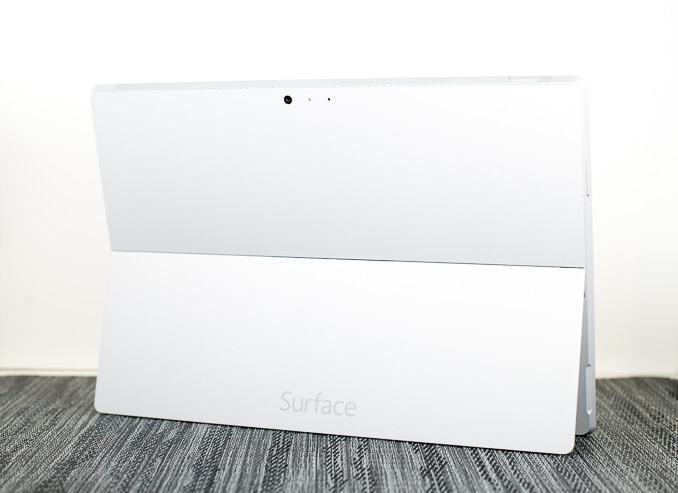
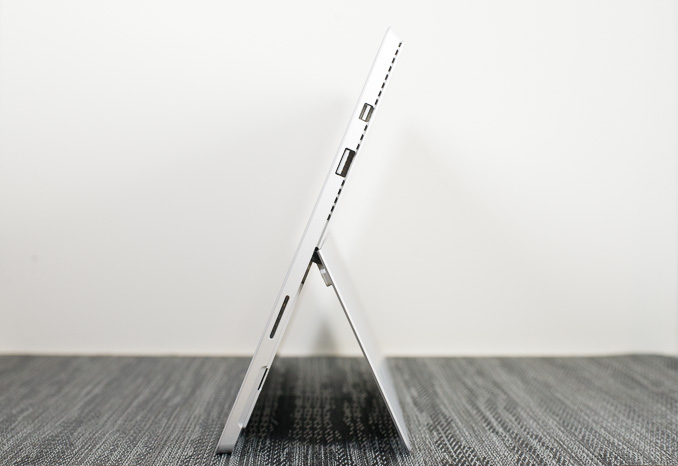
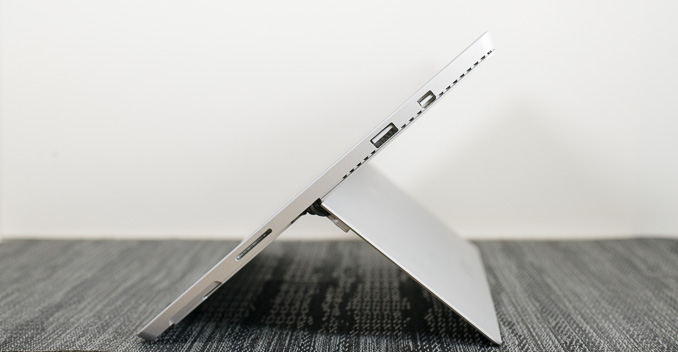

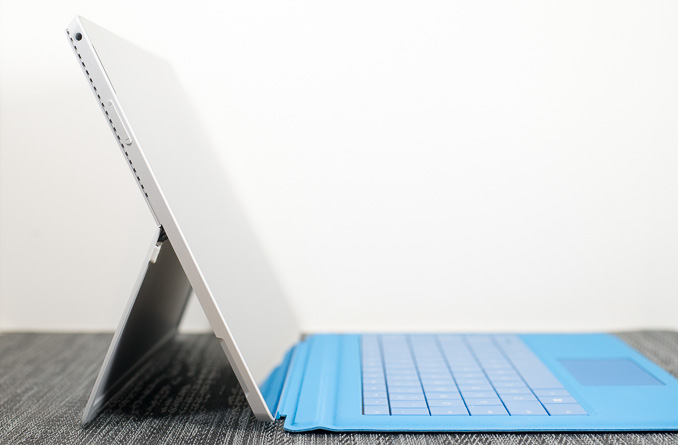
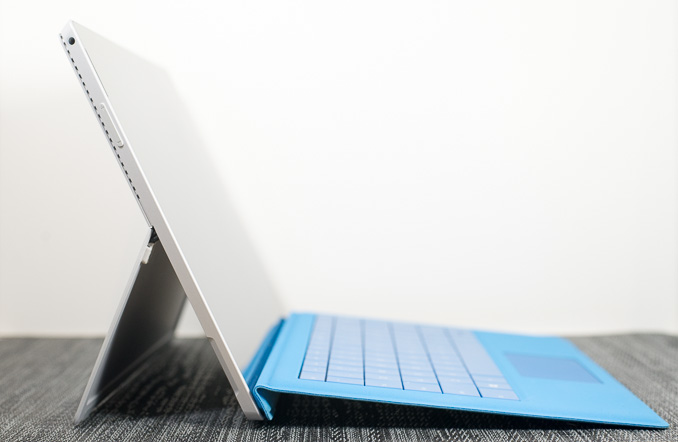








274 Comments
View All Comments
ymcpa - Monday, June 23, 2014 - link
A decent laptop is $500-$600. A decent 10" tablet is around $400. Those two devices will cost about the same as the surface. Each of those devices will perform a little better than the surface is certain tasks, but you have to carry both of those devices with you to get the same functionality as the surface. The MacBook air (don't know why you mentioned the MacBook pro which is much more expensive) has the better keyboard but can't really do any tasks that the surface can't. Same with the Ipad Air. It is lighter and has a longer battery life, but can't perform any task that the surface can't. However, you will need both those devices to perform the same task as a single surface.basroil - Tuesday, June 24, 2014 - link
Where the hell can you find a decent laptop for $600? The cheapest ones on newegg are about $800!ymcpa - Tuesday, June 24, 2014 - link
depends what your definition of decent is. The newegg list of most popular laptops has plenty of laptops in the $500's and $600's. They will probably meet the needs of many people. I used that price range because a person arguing that the surface is too expensive would most likely buy a budget laptop.basroil - Thursday, June 26, 2014 - link
"I used that price range because a person arguing that the surface is too expensive would most likely buy a budget laptop. "That has to be a joke? Microsoft is selling a premium product and makes no effort to hide it. "People say it's too expensive and instead buy a budget laptop" is not a valid response, since a decent laptop WITH THE SAME SPECIFICATIONS (other than screen of course) generally runs you just as much. Pentium, Celeron, and AMD chips are NOT decent laptop components, they are budget garbage for people who don't understand the difference.
joaoasousa - Tuesday, June 24, 2014 - link
The Surface is competing in the top end with it's high build quality and thinness, you can't compare it to plastic 600$ laptops. You must put it against similar products like the Macbook Air, Zenbook, etc.mkozakewich - Monday, June 30, 2014 - link
The Air has a better trackpad, but I wouldn't say it has a better keyboard. Different people like different things, and the Surface family has my favourite keyboard ever. I was using an HP Mini netbook in 2010 which was my previous favourite, and had a similar keyboard.Honestly, those big mechanical things just required too much horizontal and vertical travel and were annoying to use.
You're welcome to like the keyboards you like, and maybe get one of those Cherry MX mechanical keyboards, or stick with the one on the Air, but that doesn't mean something is 'better', only that it's more suited to you.
(Think of what one of those mechanical-switch people would say about the keyboard on the Macbook Air.)
PaulC543 - Tuesday, June 24, 2014 - link
Did *you* read the article, or did you just see a headline that mentioned the Surface and felt you had to criticize it?What bases does it cover? Let's see:
Media consumption tablet, check.
Light productivity work while mobile, check.
Heavy productivity work while docked, check.
Light to medium gaming, if that's your thing, check.
Single device that can handle tablet and laptop tasks, check.
In fact, this would probably be easier if you name a base the Surface *doesn't* cover, and make sure whatever you mention are tasks appropriate for notebooks/tablets. As far as I can tell, the only things you can bring up are:
Heavy mobile text entry (but put it in a dock with a desktop keyboard and mouse and it's as good as any desktop/notebook)
High-end gaming.
Latest and "greatest" "apps".
That's really about it.
As for a lower cost option, you *are* aware that Dell, Lenovo, Acer and the like are building $200-$300 Intel Atom based full Windows 8 tablets, aren't you? There's your Windows tablet entry device. Niche product? Literally everyone who's seen my Surface Pro 2 has said it's the device they want as their "mass market" iPad has proven so useless that it just sits on a shelf.
TEAMSWITCHER - Tuesday, June 24, 2014 - link
I would dispute your "Heavy Productivity While Docked" claim. Merely docking the Surface doesn't automatically give it a quad core processor with discrete graphics. So what does that leave? A single device that could serve as a Tablet or Notebook suitable for media consumption, light productivity, and lite gaming...all for the not so low price of $1177+tax (with keyboard and Pen)If your needs are humble I can see the Surface Pro 3 working well, but there are devices costing hundreds less that could do the same. I know many people who's PC's are now e-waste - an iPad and iPhone are their only devices. But for an enthusiast or power user the Surface Pro 3 will always be a secondary device to a more capable computer.
PaulC543 - Tuesday, June 24, 2014 - link
"I would dispute your...."Is your dispute based on hands-on experience? Because mine is. I attach mine to my 30 inch monitor and desktop keyboard/mouse, and it easily handles 3D modeling and Photoshop work. Certainly not to the level of my workstations, but when they're tied up rendering, the Surface easily fills in.
And this is why I said to make sure the tasks you mention are appropriate - of course it's not going to offer workstation-level performance, but no ultrabook class laptop will either.
As for the price, this has been beaten to death. The Surface is entirely in-line with ultrabook-class laptops, offers key features they typically don't (touch screen, pen input, etc.) and is able to serve as a straight tablet. Add the price of a laptop AND a tablet, and you're going to spend more and have to carry at least several times the weight/bulk of the Surface.
Everything you're written speaks quite loudly to the fact that you don't see the value in what the Surface offers and have never used one. Why, then, are you compelled to criticize a device which you clearly don't understand or would ever purchase?
TEAMSWITCHER - Tuesday, June 24, 2014 - link
I never said I didn't see value in it. I think it's a great device along the lines of other great machines like Apple's entire MacBook line and Lenovo's ThinkPad Carbon X1 Touch and Yoga 2.But your claims are just ridiculous... An iPad Air weighs only 1 pound..the iPad mini weighs much less. Adding a tablet to a notebook doesn't add "Several times the weight/bulk" it's not even 1-time the weight and bulk. Finally a two-in-one device isn't the same as having two devices. I can prop my iPad up next to my MacBook for a second screen. You can't do that trick with a Surface Pro 3, unless you carries another tablet with you.